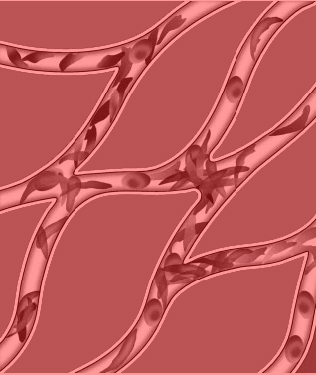|
|
|
|
What Is Sickle Cell Anemia?
Sickle cell anemia is an inherited blood disease. That means you are born with it and it lasts a lifetime.
Sickle cell anemia affects the red blood cells. Normal red blood cells are smooth and round like doughnuts. They move easily through blood vessels to carry oxygen to all parts of the body. In sickle cell anemia, the red blood cells become hard, sticky, and shaped like sickles or crescents. When these hard and pointed red cells go through the small blood vessels, they tend to get stuck and block the flow of blood. This can cause pain, damage, and a low blood count or anemia.

The sickle-shaped red blood cells tend to get stuck in
narrow blood vessels, blocking the flow of blood.
Anemia is a shortage of red blood cells in your blood. In sickle cell anemia, this shortage of red blood cells occurs because sickle cells do not last very long. It is hard for your body to make new red blood cells fast enough to keep up. Normal red blood cells last about 120 days in the bloodstream. Sickle cells die after only about 10 to 20 days.
Sickle cell trait is different from sickle cell anemia. A person with sickle cell trait does not have the disease but carries the gene that causes the disease. Persons with sickle cell trait can pass the gene to their children. For more information on sickle cell trait, see the section on "What Causes Sickle Cell Anemia."
Sickle cell anemia is a serious disease and there is no universal cure. Bone marrow transplantation offers a cure, but very few patients have matched donors. Some patients also do not want bone marrow transplants because of the risks involved. Over the past 30 years, doctors have learned a great deal about the disease. They know what causes it, what it does to your body, and how to treat many of the complications. Today, with good health care, many people with the disease:
-
Are in reasonably good health much of the time
-
Live fairly normal lives
-
Live 40 to 50 years and longer.
|
|
 Other Names Other Names
|

 DCI Home:
Blood Diseases:
Sickle Cell Anemia:
What Is ...
DCI Home:
Blood Diseases:
Sickle Cell Anemia:
What Is ...

 Other Names
Other Names

 Print all Sections of this Topic
Print all Sections of this Topic

 DCI Home:
Blood Diseases:
Sickle Cell Anemia:
What Is ...
DCI Home:
Blood Diseases:
Sickle Cell Anemia:
What Is ...

 Other Names
Other Names

 Print all Sections of this Topic
Print all Sections of this Topic